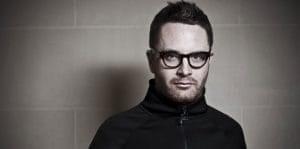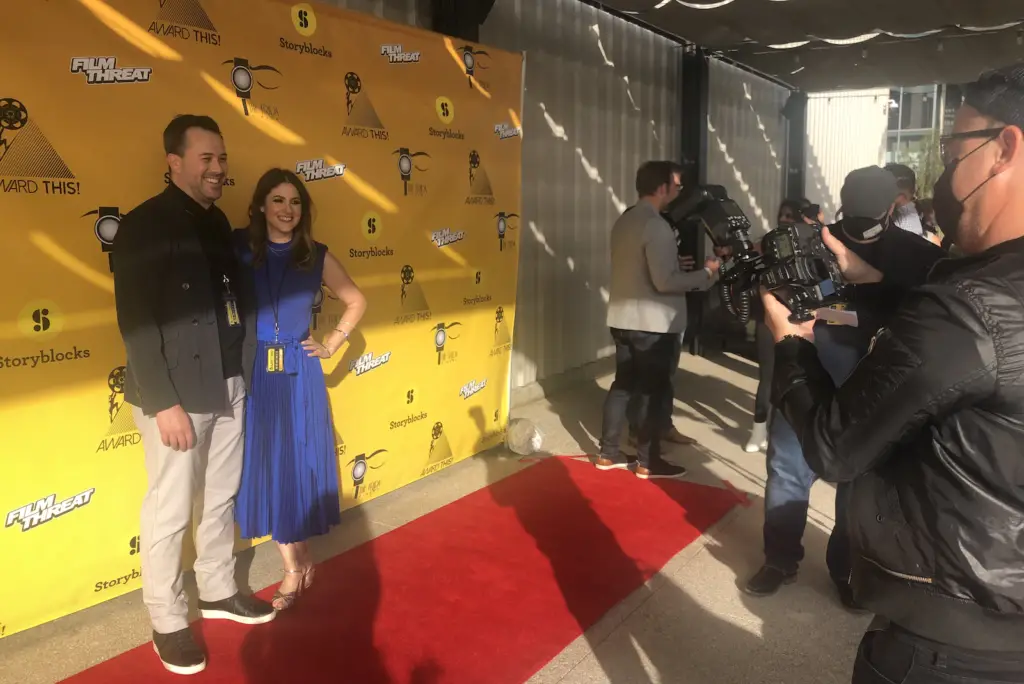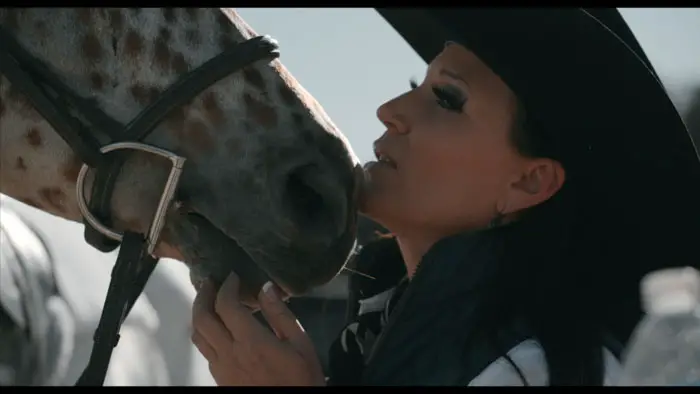
“Hold on a minute,” requests Danish director Nicolas Winding Refn from the other end of a particularly noisy telephone connection.
I’ve cornered the easily-distracted creator of “Pusher,” “Bronson,” and the current “Valhalla Rising” for a phoner, but he’s clearly overwhelmed. His two daughters, aged one and seven, plead for Dad’s attention in the background (“With two kids,” laughs Refn, “I have stereophonic sound”). I then hear the audible ring of another telephone.
“Pardon me,” Refn reports apologetically, “but I have to take this call. It’s Ryan Gosling.”
Refn has temporarily migrated from Copenhagen to LA, where he’s filming Gosling (“Lars and the Real Girl”, “The Notebook”) in the upcoming “Drive.” And judging from their barely-audible conversation (which I’m eavesdropping on during this game of “musical phones”), I conclude that the director and star get along smashingly.
“I’m talking with a very nice journalist,” Refn explains to Gosling from the second phone. “Why don’t you come over later, and we can hang out? Bring some food, and some chocolate cookies.”
Our interview has been delayed by four hours, at Refn’s request. Between vocal kids and ringing telephones, a chaotic vibe can be sensed during this fragmented landline discussion. However, once the quirky filmmaker surrenders his time and gets into the “zone,” he’s an honest, generous interview subject.
Refn doesn’t sound like a salesman, even though our conversation is meant to promote “Valhalla Rising,” a wild-eyed, hallucinatory oddity currently playing On Demand and in select theaters. Refn flat-out admits that the film’s bizarre mix of head-splitting, brain-spilling violence and open-to-interpretation symbolism will divide audiences. In fact, this often gorgeous, sometimes incomprehensible Viking odyssey might best work in tandem with chemical ingestion.
Forget IMAX and 3-D… this is eye-whacked and LSD.
“Valhalla Rising” follows One-Eye (Mads Mikkelsen), a half-blind mute seemingly impervious to death. A medieval variation on Clint Eastwood’s Man with No Name, One-Eye begins Refn’s filmic journey chained to a wooden post, the human pit pull for chieftain Barde (Alexander Morton). Like Russell Crowe’s captive Gladiator, One Eye is forced into brutal mano-a-mano combat with competing warriors from other Viking clans. It’s a vicious spectacle. Refn is heavy on gray matter, crimson red stuff, grappling limbs and meaty body-blows (think David Cronenberg’s grueling “Eastern Promises” bath-house brawl).
After an initial orgy of primal violence, “Valhalla Rising” takes a strange, unexpected turn. What begins as a ballet of kinetic impact and brute force quickly quiets down into a calming, scenic meditation on mankind’s uneasy evolution. After killing his captors, One-Eye befriends a feral young boy (struggling with a perpetual “bad hair” day that would make Carrot Top orange with envy). Both paternal brute and surrogate son join a group of ship-helming Vikings on its journey to the Holy Lands.
What follows is a free-form eye-orgy of psychedelic sights. Refn employs an eerie red lens to depict One-Eye’s prophetic visions (Mikkelsen’s hero helms supernatural powers, and can predict the future). The adventurous filmmaker abandons whiplash crosscutting and handheld chaos in favor of tranquil framing. Beautiful panoramas of sunsets, oceans, and rolling Scottish hills quickly replace the tense gore that introduces Refn’s film. Unlike conventional Hollywood fodder, “Valhalla Rising” explodes from the starting gates, and then abandons its race to picnic on the sidelines.
What you make of “Valhalla Rising” will largely depend on expectations. Through its rather misleading marketing campaign, the film’s hyperviolent trailer suggests an intense action thriller. But with its broad brushstrokes, ambiguous images, and loose structure, Refn’s movie is a more difficult experience than arrows ‘n axes epics like “Braveheart.”
Going into the film, think of “Valhalla Rising” as an open canvas, to be filled in with subjective interpretations. Take a buddy, and then knock back a few at an after-movie dinner, where you can talk about life, the world, and what Refn’s challenging movie is really all about.
Meanwhile, the following Q & A offers a window into Refn’s turbulent career. Full of disturbing flashbacks and euphoric highs, his path to success rivals the surreal vibe of “Valhalla Rising.” Refn also speaks about his lengthy working relationship with Danish superstar Mikkelsen, and offers advice to fledgling filmmakers on the financial hell of managing movie money.
“I never watch my movies once they are completed. But I have fond memories of making it…”
You’re currently shooting one film, while promoting another. Life would appear to be busy.
I’m shooting “Drive” with Ryan Gosling, while promoting “Valhalla Rising.” After the current shoot, I leave for Bangkok to film another movie called “Only God Forgives.” I enjoy shooting two films back to back. I’m busy – and looking forward to when I’m dead (laughter).
After the success of 1996’s “Pusher,” and your second film, “Bleeder” (1999), life became a bit bleak. I understand that 2003’s “Fear X,” your next movie, left you severely in debt. Phie Ambo’s 2006 documentary, “Gambler,” chronicled this tense period in your career.
I haven’t talked about “Fear X” for five or six years, but more recently, it’s coming up in people’s interview questions. It’s a film that haunts me in a way. It was a financial failure, but not artistically. It was too expensive, for the kind of distribution that a film like that can get. It taught me many valuable and painful lessons, very quickly providing knowledge on how to survive in this industry. Strangely enough, had I not done that movie, I would not have concluded the “Pusher” Trilogy, would never have made “Bronson,” and would never be doing this movie with Ryan. So it’s a film that’s very important to me. I have never seen it. I never watch my movies once they are completed. But I have fond memories of making it. You’re the first one to talk to me about it for awhile. But this is a good time… it’s a very dark and melancholy night (laughter).
You have never watched any of your completed films?
Never.
After the financial failure of “Fear X,” you were forced to make two “Pusher” sequels (2004’s “Pusher II: With Blood on my Hands” and “Pusher III: I’m the Angel of Death,” one year later) to pay off the debt. Can you elaborate?
I made them with great hatred. Basically, I felt that I had to go back and redo everything I had already done. Once I got into making them, however, I began to enjoy it a lot.
The sequels were obviously made with great care, and not just knock-offs. The third film has an incredible performance by Zlatko Buric.
I agree. Part III was my favorite one of all. It became very interesting artistically.
You have made several films with Mads Mikkelsen. Can you describe the working relationship?
I discovered him. But we have nothing in common. We never socialize. We have no connection with each other. I know he socializes with other filmmakers. But that’s because he needs the money. It’s usually me coming up with a concept. I’ll call, tell him I want him to play the character, make the movie, and then we disappear from each others’ lives. Sometimes we don’t talk for years. I would never invite him to my birthday, and would certainly never go to his.
Do you think this lack of personal socializing enhances your professional work together?
Well, it keeps our knowledge of each other sparse. It becomes more about what we do, and not who we are.
Is Mikkelsen the most popular actor in Denmark?
He’s the biggest star in Scandinavia, and certainly the best. He’s just gotten better.
In 2006, Mikkelsen played a significant role in “Casino Royale,” the hugely successful James Bond film. Did this international success change him, as an actor?
Not for me. He’s a man that doesn’t get affected by success; just whether the movie is good.
“The film was meant to be like an acid trip. It starts violently, but if you let go, and go on the trip, it’s like meditating…”
“Valhalla Rising” starts with a bang, then takes its time. Most films are a slow burn to a climax, but yours starts with an explosion of action, and then continues at a more leisurely pace.
The film was meant to be like an acid trip. It starts violently, but if you let go, and go on the trip, it’s like meditating. It’s violent to begin with, during the releasing of the body and mind. But if you stay with it, you will begin to trance. If people don’t do that for the movie, they will be very disappointed. The movie divides a lot of people. It doesn’t bother me that people have strong reactions. This means that it touches them much deeper.
You use red lenses to convey One-Eye’s glimpses into the future. It’s an eerie effect.
It shows that he has powers of supernatural status. He’s essentially a god, but a god in sense of what the others make of him. He has powers, but doesn’t know why he can see the future. He doesn’t realize why, until he participates in a hallucinogenic journey, in which he becomes active. He builds his own monolith. He represents Faith. From Faith comes Religion, and from Religion becomes Organized Religion.
In the 1100’s, Christianity spread through Europe. Prior, there was Paganism. They never forced themselves upon other religions. Then Christianity was sold to them for money, or it sold Jesus as a warrior who died in battle, or it started war. Paganism didn’t care what you believed. They killed for other reasons (laughter). But Christianity became organized.
One-Eye kind of represents the organization of religion. He starts as a primal beast, then becomes a warrior who can use tools, like the monkeys in “2001: A Space Odyssey.” He then becomes a god, because other people perceive that he’s led them to (an unexpected destination at film’s end – to disclose more would be a spoiler). He now understands that his powers have a purpose. He has become a man.
There are many beautiful images of nature, including clouds, mountains, and water. Where were these shot? Were they spliced into the film during editing, or filmed on location with the rest of the movie?
We shot the movie in Scotland, for nine weeks. The first part was shot in a very barren region. Later, the boat sequence was filmed in one week, in a studio. I wanted it to feel like space travel, so I made it very artificial. Then we filmed up north, in the Loch Ness region, to shoot the final part of the film. I shoot each of my films in chronological order, from the first scene on. It’s difficult. But I understand better what I do that way. Otherwise, it alienates me.
“…it’s better to drown when you’re young than twenty years later.”
You mentioned that “Fear X” taught you lessons about how to survive in the film industry. Would you consider imparting some of these lessons to fledgling filmmakers who might be reading this interview?
I had invested too much in preproduction. I would never get that much money back from the movie. Other people involved had been spending so much money, that if I did not make the movie, it would hurt me. It taught me the power of money. While I was happy with the material, I was not happy with casting. Casting was forced upon me from investors and sales companies who put money into the movie. I should have realized that casting doesn’t really make a difference, unless you have really big names. What matters is whether or not it’s a good movie.
Basically, it taught me to be careful with budgets, and not to make a film more expensive than what you could possibly make from it. It was a learning curve, and taught me that just because you have a few early hits don’t mean you can walk on water. But it’s better to drown when you’re young than twenty years later.
Originally posted on July 28, 2010.


